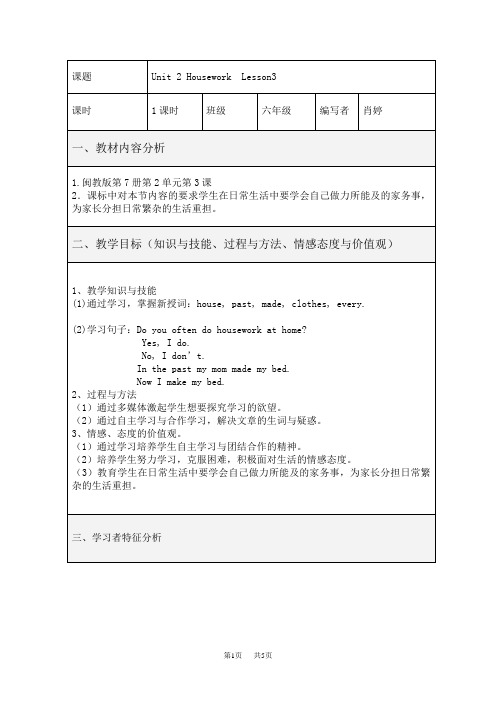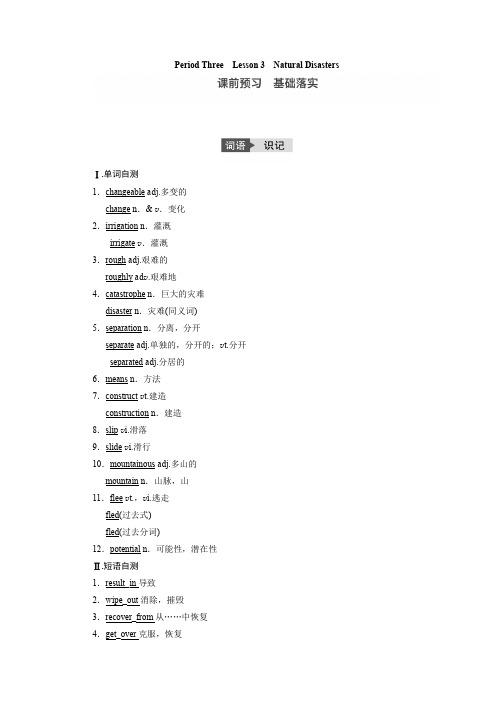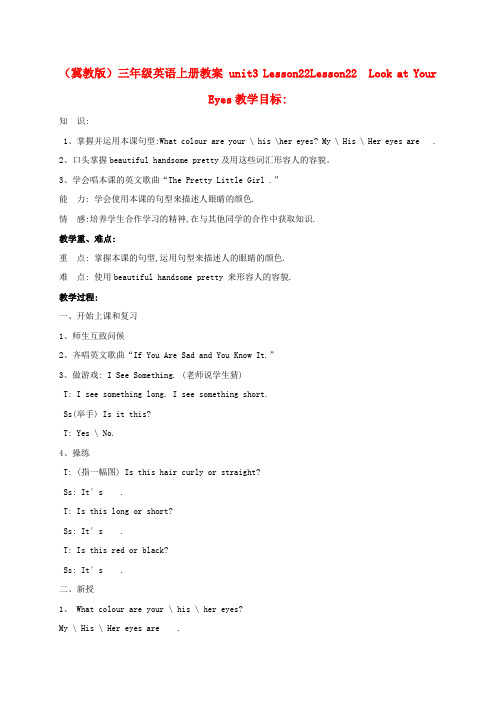Unit22 Lesson3&Communication Workshop
- 格式:doc
- 大小:58.00 KB
- 文档页数:3


冀教版(三起)三年级上册《Unit 3 I Love My Family 》(lesson 22)同步练习卷一、读一读,选择正确的答案.1. 你想知道别人有多高,你应该说﹣﹣()A.How tall are you?B.How long are you?C.How high are you?2. 当你想知道你的朋友的体重时,你应该说:_______()A.How tall are you?B.How old are you?C.How heavy are you?3. 你想知道别人多大了,你应该说﹣﹣()A.How old are you?B.How long are you?C.How tall are you?4. 你想知道这个东西的价格,你应该说﹣﹣()A.How many are there in your family?B.How much is it?C.How are you?二、看一看,连一连.It's________ (cold / hot) today. You can wear your shorts.________ (Wait / Stop) at a red light.How________ (tall / taller) is he?My eyes are________ (bigger / shorter) than yours. How________ (heavy / height) are you? I'm 38 kg.参考答案与试题解析冀教版(三起)三年级上册《Unit 3 I Love My Family 》(lesson 22)同步练习卷一、读一读,选择正确的答案.1.【答案】A【考点】情景交际My Family【解析】How tall are you?你多高?【解答】本题考查情景询问.How tall are you?你多高?How short are you?你多长?How high are you?你多高?形容人的身高用tall.你想知道别人有多高,你会问他:How tall are you?(你多高)?故选:A.2.【答案】C【考点】情景交际My Family【解析】你有多重?【解答】考查情景询问.A.How tall are you?你有多高?B.How old are you?你几岁了?C.How heavy are you?你有多重?当你想知道你的朋友的体重时,你应该说:How heavy are you?故选:C.3.【答案】A【考点】年龄My Family【解析】How old are you?你多大?【解答】本题考查年龄.选项A译为你多大?选项B译为你多长?选项C译为你多高?故当你想知道别人多大了,你应该说"How old are you?"故选:A.4.【答案】B【考点】情景交际My Family【解析】它是多少钱?【解答】考查情景询问.A.How many are there in your family?你家有几口人?B.How muchis it?它多少钱?C.How are you?你好吗?结合语境"你想知道这个东西的价格,你应该说__"可知,应该说"它是多少钱?"How much is it?故选:B.二、看一看,连一连.【答案】D,B,C,E,A【考点】固定搭配My Family【解析】(1)长江有多长?它大约有6300千米长.(2)你多高?我158厘米高.(3)那座山有多高?1000多千米高.(4)你多大年龄?我十二岁.(5)你的T恤衫多少钱?三十元.【解答】(1)D.考查长度询问.问句How long is the Changjiang River意思为:长江有多长?how long提问多长,答语回答长度.D选项It's about 6300 km long意思为:它大约有6300千米长.符合题意.故选:D.(2)B.考查身高询问.问句How tall are you意思为:你多高?how tall提问身高.B选项I'm 158 cm tall意思为:我158厘米高.符合题意.故选:B.(3)C.考查高度询问.问句How high is that mountain意思为:那座山有多高?how high提问高度.C选项Over 1000 km high意思为:1000多千米高.符合题意.故选:C.(4)E.考查年龄询问.问句How old are you意思为:你多大年龄?how old提问年龄.E选项I'm 12意思为:我十二岁.符合题意.故选:E.(5)A.考查价格询问.问句How much is your T﹣shirt意思为:你的T恤衫多少钱?how much提问金钱数量.A选项Thirty yuan意思为:三十元.符合题意.故选:A.三、选词填空【答案】hot【考点】【解析】今天很热,你可以穿你的短裤.【解答】本题主要考查单词填空.cold意思为:寒冷的;hot意思为:炎热的.由后一句可知,应该是天气炎热所以穿短裤.故填:hot.【答案】Stop【考点】单词、词组My Family【解析】红灯停.【解答】本题主要考查单词填空.wait意思为:等待;stop意思为:停止,stop at+地址,表示停在哪里.是固定搭配,wait后面的介词为for.故填:Stop.【答案】tall【考点】单词、词组My Family【解析】他多高?【解答】本题主要考查单词填空.tall意思为:高的;taller是tall的比较级形式,意思为:更高的,题干可知,没有比较对象,只是在询问:你多高?所以用形容词原形.故填:tall.【答案】bigger【考点】单词、词组My Family【解析】我的眼睛比你的大.【解答】本题主要考查单词填空.bigger意思为:更大的;shorter意思为:更短的.eyes意思为:眼睛,眼睛应该是比较大小而不是长短.故填:shorter.【答案】heavyMy Family【解析】你多重?我38千克.【解答】本题主要考查单词填空.heavy意思为:重量;height意思为:高度.由答语可知,应该在询问重量,而不是高度.故填:heavy.。

Period Three Lesson 3Natural DisastersⅠ.单词自测1.changeable adj.多变的change n.& v.变化2.irrigation n.灌溉irrigate v.灌溉3.rough adj.艰难的roughly ad v.艰难地4.catastrophe n.巨大的灾难disaster n.灾难(同义词)5.separation n.分离,分开separate adj.单独的,分开的;v t.分开separated adj.分居的6.means n.方法7.construct v t.建造construction n.建造8.slip v i.滑落9.slide v i.滑行10.mountainous adj.多山的mountain n.山脉,山11.flee v t.,v i.逃走fled(过去式)fled(过去分词)12.potential n.可能性,潜在性Ⅱ.短语自测1.result_in导致2.wipe_out消除,摧毁3.recover_from从……中恢复4.get_over克服,恢复5.turn_on攻击6.earn_one's_living谋生7.in_advance提前8.to_some_degree在某种程度上1.The_last_few_years_have_seen environmental disasters on a grand scale,and experts are predicting far worse to come.在过去的几年里,人们已经经历了大规模的环境灾难,专家们预测更为严重的灾难即将来临。
2.Storms have been getting worse everywhere too,with_a_growing_number_of_hurricanes_hitting the US,and Central America.暴风雨愈发四处肆虐,越来越多的飓风袭击美国和美洲中部。



(冀教版)三年级英语上册教案 unit3 Lesson22Lesson22 Look at YourEyes教学目标:知识:1、掌握并运用本课句型:What colour are your \ his \her eyes? My \ His \ Her eyes are .2、口头掌握beautiful handsome pretty及用这些词汇形容人的容貌。
3、学会唱本课的英文歌曲“The Pretty Little Girl .”能力: 学会使用本课的句型来描述人眼睛的颜色.情感:培养学生合作学习的精神,在与其他同学的合作中获取知识.教学重、难点:重点: 掌握本课的句型,运用句型来描述人的眼睛的颜色.难点: 使用beautiful handsome pretty 来形容人的容貌.教学过程:一、开始上课和复习1、师生互致问候2、齐唱英文歌曲“If You Are Sad and You Know It.”3、做游戏: I See Something. (老师说学生猜)T: I see something long. I see something short.Ss(举手) Is it this?T: Yes \ No.4、操练T: (指一幅图) Is this hair curly or straight?Ss: It′s .T: Is this long or short?Ss: It′s .T: Is this red or black?Ss: It′s .二、新授1、 What colour are your \ his \ her eyes?My \ His \ Her eyes are .① 示范老师指书上的图画和学生一起读 blue eyes、brown eyes 、green eyes、 black eyes 再指另一幅图画,提问What colour are his \her eyes? 学生回答 His \ Her eyes are②操练老师引导学生进行问答,要求使用物主代词 my you his herT: (指一同学) What colour are his \ her eyes ?(领读此句)Ss (跟老师说) What colour are his \ her eyes ?T: His \ Her eyes are .Ss: His \ Her eyes are .T: (问学生) What colour are your eyes?Ss: My eyes are .T: (指一个学生的眼睛) What colour are your eyes?Ss: My eyes are .T: Yes, they are .③ 播放课文录音No.1让学生看书跟读.④ 小组练习让学生自由结伴,结成三人小组,轮流问答关于眼睛颜色的问题,可指看书中的图来问,也可指同学的眼睛来问.⑤ 老师告诉学生们根据指令画画儿:T: Draw a boy. He has two heads. He has purple eyes. He has red curly hairDraw a girl. She has six legs.She has green eyes.She has long blond hair.2、 beautiful handsome pretty①示范告诉学生man woman用于说明成年人boy girl 用于小孩beautiful意为“美丽、漂亮、优美” handsome意为“漂亮、俊俏、潇洒” pretty意为“漂亮、可爱”.让学生跟老师重复读几遍这些词,然后展示这些词应怎样搭配如: Handsome man. He is handsome.Beautiful woman She is beautiful.Pretty girl. She is pretty.②播放课文录音No.2让学生看书跟读.③教唱歌曲“The Pretty Little Girl”让学生仔细观察树上小女孩的几幅图片,要求学生说出他们再图片看到的那些东西的名称(tree 、grass、girl、arms等)让学生跟老师逐句学唱,最后学生一齐跟录音唱三、结束课堂教学1检查理解情况2做《活动手册》3 Say ”Goodbye !” to the students.板书设计Lesson22 Look at Your EyesWhat colour are your \ his \her eyes?My \ His \ Her eyes are .beautiful handsome prettyWoman man girlShe is beautiful. He is handsome. She is pretty。
冀教版(8A) Lesson 22 Presents from Canada 句型分析1 LET’s Do IT!Make a birthday card for one of your classmates.Tell him or her why he or she is a special person.Don’t forget to make the card beautiful!做一做!为你的一个同学制作一张生日贺卡。
告诉他或她为什么他或她是一个特殊的人。
别忘了把卡片做得精美呀!1.They are going to send cards and presents to China.他们将把这些卡片和礼物寄往中国。
send...to...的意思是“把……寄发给……”,也可以变为send sb.sth.,即说明send后可以接双宾语。
如:I'll send Grandmother a gift on her birthday.=I’11 send a gift to Grandmother on her birthday.祖母生日我要寄给她一件礼物。
send sb.to+动词原形表达的意思是“派、打发某人做某事”。
如:He was sent to buy some milk.他被派去买牛奶。
Who sent you to do such work? 谁派你去做那样的工作?2.Jenny passes him her card.珍妮把卡片递给他。
pass sb.sth.=pass sth.to sb.“把某物递给某人”的意思。
pass在这里的意思是“传递”,后面也接双宾语。
如:Please pass me today’s newspaper.请把今天的报纸递给我。
The little girl passed an apple to me and then ran away.那个小女孩递给我一个苹果,然后跑开了。
三年级下册英语22课
三年级下册英语22课通常涉及到一些基本的英语词汇、语法和句型。
以下是包含在这一课中的一些内容,仅供参考:
1.词汇:学习与课程主题相关的词汇,如水果、动物、家庭成员、数字、颜色等。
2.语法:学习一般现在时的肯定句、否定句和疑问句形式,以及一些基本的形容词和副词的使用。
3.句型:练习使用简单的英语句型进行交流,如“Hello!How are you?”,“I like apples”,“She has a dog”等。
4.听力和口语:通过听录音或老师朗读来理解和模仿英语的发音和语调,并进行口语练习。
5.阅读和写作:可能会阅读一些简单的英语故事或短文,并尝试写出一些简单的句子或段落。
这只是一个大概的内容描述,具体的课程内容可能因教材和教学方法的不同而有所差异。
(冀教版)六年级英语下册《unit3 Lesson22》教案设计一、教学目标语言知识目标1.让学生能够正确听、说、读、写单词 blue、hand、eye、leg、mouth。
2.让学生能够使用正确的动词进行描述观察到的人体部位的颜色以及大小。
情感态度价值观目标1.在课堂上增强学生的口语交流能力。
2.在课堂上增强学生的合作意识与团队精神。
二、教学重点1.学习使用正确的动词进行人体部位的描述。
2.积极参与课堂活动,并与同伴合作完成任务。
三、教学难点1.通过观察,正确描述人体部位属性,如颜色、大小等。
2.学生能够使用正确的语法进行句子的描述。
四、教学过程1. 导入新课1.让学生自由表演下课前背的课文。
2.老师给予学生鼓励和肯定,提高学生参与课堂的积极性。
2. 学习新知识1.老师出示人体图,让学生依次描述人体各部位颜色、大小等;2.讲解单词blue、hand、eye、leg、mouth;3.让学生认真听老师的读音,然后模仿即可准确地发音;4.给学生展示有关人体颜色、大小的图片;3. 独立练习1.让学生分成小组,自行组织语言进行描述,并记录下所得到的相关语句;2.学生可以通过小组内部进行讨论,然后向全班展示他们的创意和机智;3.在小组内部,培养学生相互协作、分工合作的意识,增强学生的团队合作精神。
4. 总结课堂内容1.老师让学生用几分钟时间总结课堂内容,分头发言;2.通过总结,让学生加深对新知识的理解与记忆,便于巩固知识点。
5. 课后作业1.老师布置口头英语作业,要求学生通过观察环境、身边的事物并加以描写,复习所学单词;2.布置英语阅读作业,交流自己的看法和观点。
五、教学反思通过本课的教学,学生们在加深对人体各部位的了解以及语法知识的掌握方面取得了一些进步。
通过课堂做游戏、展示活动、小组讨论等方式,培养了学生们合作与团队精神,让他们感受到了英语学习的乐趣与实用性。
八上英语外研版课文翻译全部八上英语外研版课文的翻译如下:Unit 1: School Life.Lesson 1: Welcome to the unit.欢迎来到本单元。
Lesson 2: School subjects.学校科目。
Lesson 3: School activities.学校活动。
Lesson 4: My school day.我的学校生活。
Unit 2: Hobbies and Interests.Lesson 1: My hobbies.我的爱好。
Lesson 2: What do you want to be?你想成为什么?Lesson 3: What are you doing for vacation?你暑假打算做什么?Lesson 4: My favorite sport.我最喜欢的运动。
Unit 3: My Friends.Lesson 1: Making friends.交朋友。
Lesson 2: My best friend.我最好的朋友。
Lesson 3: Friends around the world.世界各地的朋友。
Lesson 4: My favorite singer.我最喜欢的歌手。
Unit 4: Our Country.Lesson 1: China's geography.中国的地理。
Lesson 2: China's population.中国的人口。
Lesson 3: China's history.中国的历史。
Lesson 4: Chinese inventions.中国的发明。
Unit 5: Festivals and Celebrations. Lesson 1: Festivals in China.中国的节日。
Lesson 2: Festivals around the world.世界各地的节日。
Lesson 3: Celebrations in my family.我家的庆祝活动。
Unit 22 L3&Communication Workshop学案Ⅰ.请根据汉语意思写出英语单词、短语或根据英语单词、短语写出汉语意思1. 多变的________________________________________2. 逃走__________________________________________3. 消极的,负面的_________________________________4. 计算, 算出____________________________________5. 在...范围之内__________________________________6. 导致__________________________________________7. 谋生__________________________________________8. 塞住耳朵______________________________________9. 总结,概括______________________________________10. 摆脱,脱离______________________________________11. typhoon________________________________________12. rough__________________________________________13. separation______________________________________14. construct_______________________________________15. potential_______________________________________16. adopt_________________________________________17. considerate_____________________________________18. allocate________________________________________19. fragile_________________________________________20. valid__________________________________________21. evolution______________________________________22. carve__________________________________________23. cubic__________________________________________24. as a matter of fact________________________________25. to some degree__________________________________26. on the increase__________________________________Ⅱ. 完型填空This was an unforgettable and wonderful experience.It happened about three years ago and it has had a 1 effect on me.I would like to show respect here for the two men I do not know 2 but whose actions gave a new 3 to the words — kind and generous.I was walking down a busy street on a cold, windy day in early 4 . A homeless man, probably about 60 and without wearing any shoes, was 5 for change on a street corner.A BMW car 6 on the other side of the street and an executive(主管)who was perfectly dressed stepped out of the car.He was probably about 7 years old.He was wearing a blue business suit with a deep red silk tie.He walked 8 across the street and over to the homeless man.Without saying anything, he first gave him a lot of 9 and then he sat down and took off his leather gloves, beautiful black leather shoes and his black dress socks.Then he 10 them to the homeless man.The homeless man took them and stared with a/an 11 mouth.As he drove off, I couldn’t 12 thinking that it was probably the first time he had 13 the pedal(踏板)of that top-brand BMW car with a 14 foot! I stood there and the looks of 15 appeared on my face and the homeless man’s.Two men of about the same age 16 very different lives had met and the one who was 17 in materials had offered 18 than his shoes.He had left this BMW car and 19 down from his high position.He lifted up the other man when he offered respect, 20 and real generosity.1.A.strong B.bad C.light D.slow2.A.officially B.Personally C.similarly D.generally3.A.benefit B.attitude C.meaning D.award4.A.spring B.summer C.autumn D.winter5.A.searching B.making C.blaming D.begging6.A.called up B.broke up C.pulled up D.sped up7.A.40 B.50 C.60 D.708.A.directly B.usually C.unwillingly D.fluently9.A.money B.water C.sand D.oil10.A.posted B.handed C.kicked D.threw11.A.closed B.full C.open D.empty12.A.stand B.delay C.forget D.help13.A.bended B.cut C.repaired D.pressed14.A.relaxed B.large C.bare D.single15.A.excitement B.astonishment C.sadness D.pride16.A.but B.or C.and D.before17.A.successful B.careful C.useful D.helpful18.A.rather B.more C.other D.better19.A.broken B.fell C.stepped D.rolled20.A.surprise B.disappointment C.anxiety D.kindnessⅢ. 阅读理解Have you ever heard the saying “All roads lead to Rome”? At one time, this was pretty much true. During the Roman Empire, lots of roads were built in order to move armies, send messages by courier (信使), and make trade easier. This construction work went on for five centuries! If all the roads built during the Roman Empire were put together end to end, they would circle the equator twice.The network of Roman roads was begun in 312 BC. It was demanded that the roads be built strong so that they would not fall down. Roman soldiers, supervised (监督) by engineers, laid down the roads in a special pattern of layers. The first layer was made of sand. Next, the builders added rocks and rubble. On top of these materials came gravel. On this solid foundation, the road builders placed paving stones.Also, Roman roads were cambered. This means that they were built higher in the middle than on the edges, allowing rainwater to run off, which prevented flooding. We use the same technique in building roads today. The Romans also laid out roads over hills when necessary, setting them down in a zigzag pattern to make the road rise gradually.All Roman roads had milestones (里程碑), placed every thousands paces (a Roman mile). The milestones told when the road was built, who was emperor at the time, the road’s destination, how far the traveler was from the destination, and how many miles had been traveled since the beginning of the road. This information was a great help to travelers.Because of their excellence in construction, it really is no surprise that many parts of Roman road still exist today. These roadways are one of the most impressive accomplishments of the Roman Empire.1. What does the underlined sentence in the first paragraph mean?A. The Roman Empire was very powerful.B. Lots of roads were built during the Roman Empire.C. The roads built during the Roman Empire were very long.D. The roads built during the Roman Empire were very convenient.2. Which of the following correctly shows the structure of the Roman roads?3. The following description about Roman roads is true EXCEPT _____.A. Roman roads were built by the Roman soldiers directed by the engineersB. Roman roads could prevent flooding using the technique abandoned todayC. Roman roads had milestones that were placed every other Roman mileD. Roman roads still exist today as an impressive achievement of Roman Empire4. What information can you find on the milestones?A. The builders of the road.B. The materials used in building roads.C. The distance from one city.D. The time spent in building roads.5. The passage mainly ______.A. explains the saying “All roads lead to Rome”B. praises ancient Romans for their great achievementsC. shows how great the Roman Empire wasD. introduces the construction of the Roman roadsⅣ. 短文改错下文中共有10处语言错误,每句中最多有两处。